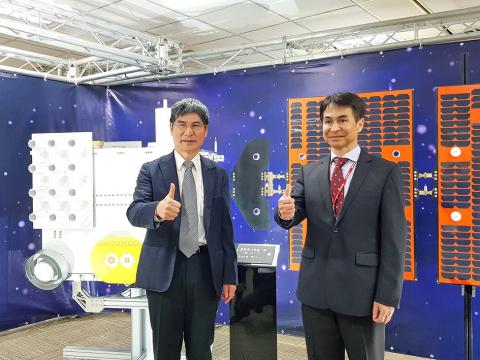The Ministry of Science and Technology yesterday announced plans to focus on the development of 10 small, high-resolution satellites for the third phase of the National Space Program.
The third phase, which is expected to cost NT$25.1 billion (US$814 million), was last month approved by Premier Su Tseng-chang (蘇貞昌).
It was the first official document he signed after taking office.

Photo: Chien Hui-ju, Taipei Times
It is to be executed by the National Applied Research Laboratories and the National Space Organization (NSPO) over a 10-year period starting this year, the ministry said.
The initiative would focus on the development of six prototype high-resolution optical remote sensing satellites, two ultra-high resolution smart optics remote sensing satellites and two synthetic aperture radar (SAR) satellites, it said.
It would also focus on the development of remote sensing technology and the use of smaller satellites to achieve higher resolution images, Minister of Science and Technology Chen Liang-gee (陳良基) said.
Citing an example, Chen said an ultra-high resolution smart optics remote sensing satellite weighing about 200kg would give users a 35cm view of the ground from an altitude of 510km, which would be the equivalent of spotting a cat or a dog in Pingtung County’s Kenting (墾丁) area from the Taipei 101 building.
The ministry plans to launch one satellite a year, he said, adding that the first is expected to be launched in 18 months.
The achievements of the first and second phases would serve as the foundation for the third phase, Chen said.
He hopes that the National Space Program would encourage innovation in the field of science, he added.
The prototype high-resolution optical remote sensing satellite constellation, which is to include three sets of two satellites, would raise the frequency of Formosat-5’s revisit rate from once every two days to twice or three times a day, NSPO director-general Lin Chun-liang (林俊良) said.
This would allow the ministry to gather more images, which has positive implications for the implementation of government policies, rescue missions, disaster prevention and scientific research, he said.
Ultra-high resolution smart optics remote sensing satellites focus on sub-meter resolution images, Lin said.
SAR satellites, which are equipped with active radar, are unaffected by cloud cover, fog or rainfall, which means they can function no matter the weather conditions or time of day, he said.
Other plans for the third phase include space exploration and the development of a satellite capable of orbiting the moon, Lin added.
As Taiwan lacks experience in these areas, it hopes to achieve its goal of space exploration by partnering with domestic and foreign academia, he said.
Having a satellite orbiting the moon would be the first step, he said.
Researchers would also explore ways to land a satellite on the moon, Lin added.
Without the assistance of GPS on the moon, the satellite would need to guide its own landing, he said.
Asked about the launch date of Formosat-7, Lin said that as Taiwan is partnering with the US for the launch, it would need to wait for the US to notify them.
Formosat-7’s six satellites are on standby at the NSPO, and can be packaged and delivered to the US as soon as it receives notice from the US, he said.
The ministry plans to launch Formosat-7 this year and a weather satellite called the “wind hunter” next year, Chen said.

US climber Alex Honnold is to attempt to scale Taipei 101 without a rope and harness in a live Netflix special on Jan. 24, the streaming platform announced on Wednesday. Accounting for the time difference, the two-hour broadcast of Honnold’s climb, called Skyscraper Live, is to air on Jan. 23 in the US, Netflix said in a statement. Honnold, 40, was the first person ever to free solo climb the 900m El Capitan rock formation in Yosemite National Park — a feat that was recorded and later made into the 2018 documentary film Free Solo. Netflix previewed Skyscraper Live in October, after videos

Starting on Jan. 1, YouBike riders must have insurance to use the service, and a six-month trial of NT$5 coupons under certain conditions would be implemented to balance bike shortages, a joint statement from transportation departments across Taipei, New Taipei City and Taoyuan announced yesterday. The rental bike system operator said that coupons would be offered to riders to rent bikes from full stations, for riders who take out an electric-assisted bike from a full station, and for riders who return a bike to an empty station. All riders with YouBike accounts are automatically eligible for the program, and each membership account

NUMBERS IMBALANCE: More than 4 million Taiwanese have visited China this year, while only about half a million Chinese have visited here Beijing has yet to respond to Taiwan’s requests for negotiation over matters related to the recovery of cross-strait tourism, the Tourism Administration said yesterday. Taiwan’s tourism authority issued the statement after Chinese-language daily the China Times reported yesterday that the government’s policy of banning group tours to China does not stop Taiwanese from visiting the country. As of October, more than 4.2 million had traveled to China this year, exceeding last year. Beijing estimated the number of Taiwanese tourists in China could reach 4.5 million this year. By contrast, only 500,000 Chinese tourists are expected in Taiwan, the report said. The report

Temperatures are forecast to drop steadily as a continental cold air mass moves across Taiwan, with some areas also likely to see heavy rainfall, the Central Weather Administration (CWA) said. From today through early tomorrow, a cold air mass would keep temperatures low across central and northern Taiwan, and the eastern half of Taiwan proper, with isolated brief showers forecast along Keelung’s north coast, Taipei and New Taipei City’s mountainous areas and eastern Taiwan, it said. Lows of 11°C to 15°C are forecast in central and northern Taiwan, Yilan County, and the outlying Kinmen and Lienchiang (Matsu) counties, and 14°C to 17°C